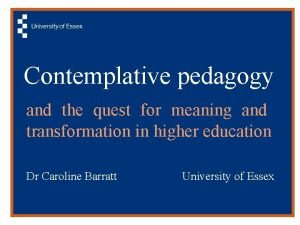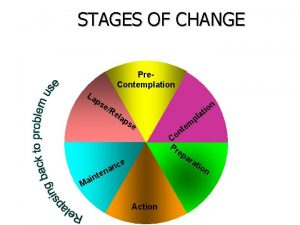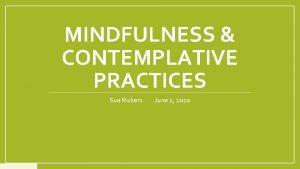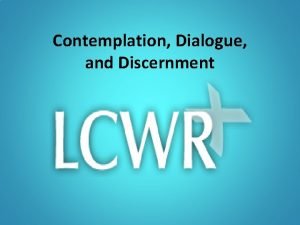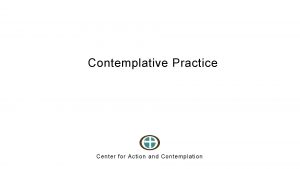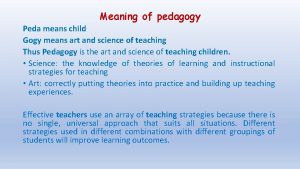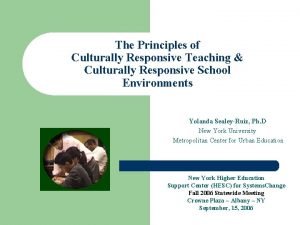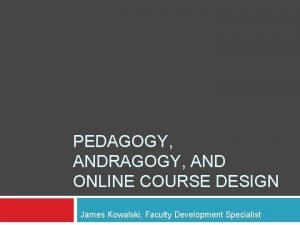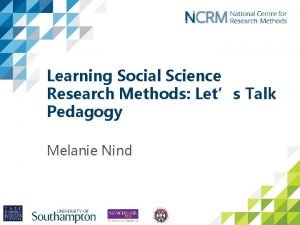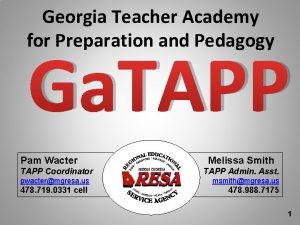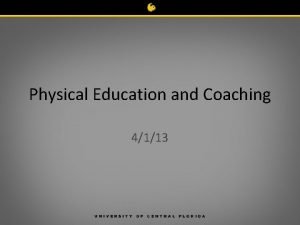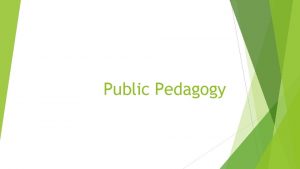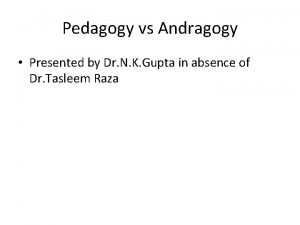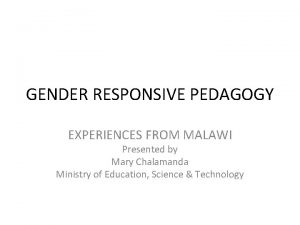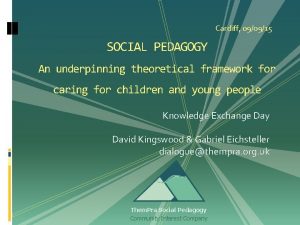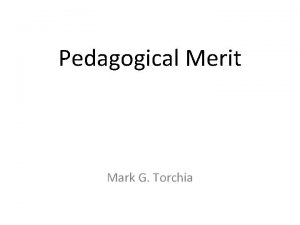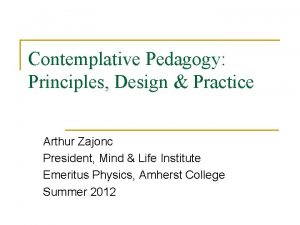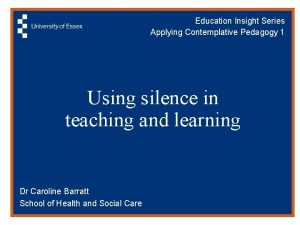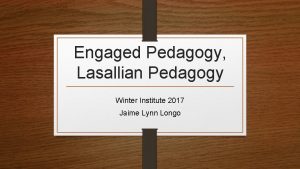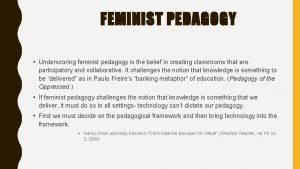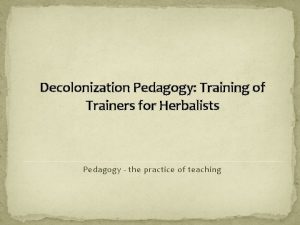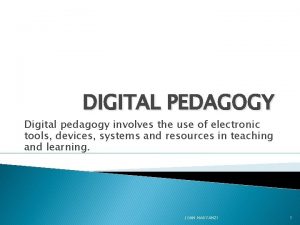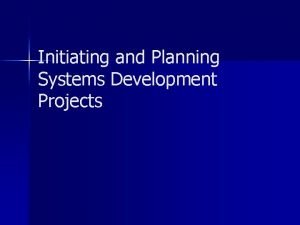Contemplative pedagogy and the quest for meaning and




![What is contemplative pedagogy? “[contemplative pedagogy] presumes that the capacities of sustained voluntary attention, What is contemplative pedagogy? “[contemplative pedagogy] presumes that the capacities of sustained voluntary attention,](https://slidetodoc.com/presentation_image/3da805c0efe9ddcf21839749727d53d1/image-5.jpg)



![A ‘qualitative dimension’… “Whereas critical consciousness privileges the world of words…[the] contemplative relishes in A ‘qualitative dimension’… “Whereas critical consciousness privileges the world of words…[the] contemplative relishes in](https://slidetodoc.com/presentation_image/3da805c0efe9ddcf21839749727d53d1/image-9.jpg)













- Slides: 22

Contemplative pedagogy and the quest for meaning and transformation in higher education Dr Caroline Barratt University of Essex

Outline § What is contemplative pedagogy and why has it become prominent now? § How is it connected to and informed by other pedagogies? § How can contemplative pedagogy assist us in our quest for meaning and transformation in higher education?

Contemplation in learning is not new. . . …but is has been neglected Owen-Smith (2018) Photo credit: David Searle/Flickr

What is contemplative pedagogy? “We want to create the opportunity for our students to…feel deeply and experience themselves within their education” (Barbezat and Bush 2014: 3)
![What is contemplative pedagogy contemplative pedagogy presumes that the capacities of sustained voluntary attention What is contemplative pedagogy? “[contemplative pedagogy] presumes that the capacities of sustained voluntary attention,](https://slidetodoc.com/presentation_image/3da805c0efe9ddcf21839749727d53d1/image-5.jpg)
What is contemplative pedagogy? “[contemplative pedagogy] presumes that the capacities of sustained voluntary attention, emotional balance, insight, and compassion are able to be developed through practice… Full comprehension means that we understand the world from inside as well as the outside” (Zajonc 2014: 93)

What is contemplative pedagogy? “Contemplative pedagogy shifts the focus of teaching and learning to incorporate ‘first person’ approaches which connect students to their lived, embodied experience of their own learning…[enabling] them to form richer, deeper, relationships with their peers, their communities and the world around them. ” (Barratt 2014)

What is contemplative pedagogy? “Second person approaches to contemplative education involve exploring contemplative experience from an intersubjective position that is represented spatially as between us, in contrast to inside us (subjective position) or outside us (objective position)” (Gunnlaughson 2009: 27)

Centre for Contemplative Mind in Society
![A qualitative dimension Whereas critical consciousness privileges the world of wordsthe contemplative relishes in A ‘qualitative dimension’… “Whereas critical consciousness privileges the world of words…[the] contemplative relishes in](https://slidetodoc.com/presentation_image/3da805c0efe9ddcf21839749727d53d1/image-9.jpg)
A ‘qualitative dimension’… “Whereas critical consciousness privileges the world of words…[the] contemplative relishes in the wordless, though tangible, dimensions of experience. That is why it defies definition. ” (Mah y Busch 2014: 126)

Critical & radical pedagogies Contemplative studies Contemplative pedagogy Mindfulness in education Transformative pedagogy

Transformative learning “a deep, structural shift in basic premises of thought, feelings, and actions” (Transformative Learning Centre 2004) “learning is understood as a process of using a prior interpretation to construe a new or revised interpretation of the meaning of one's experience in order to guide future action” (Mezirow, 1996: 162)

Meaning and transformation “. . . we not educated in making meaning of this internal life…The more we lean towards attending out there, the more our reality is defined by that which we find out there to which we attribute worthiness and meaning” (Ergas 2017: 131)

How does contemplative practice lead to transformation? § Become aware of habits and taken for granted § Deepening understanding of and valuing their inner life § Development of awareness allows greater intentionality and therefore change § May reduce stress and makes space for ‘not knowing’ § Values stillness and silence as well as dialogue and connection

Transforming students. . . “The deep listening technique had given me breathing space to centre myself and to breathe, helping me to slow down my thoughts and to contain the emotion of panic I was feeling and to accept it was there and to allow the feelings and thoughts to pass. ” Quote from unpublished data collected from ‘Developing as a Compassionate Practitioner’ students

Transforming students. . . “I was able to write a very clear treatment plan, perhaps because I had gained a far deeper understanding of Emily’s needs through an enhanced presence within the sessions…I was able to feel calmer, and better able to focus…” Quote from unpublished data collected from ‘Developing as a Compassionate Practitioner’ students

Transforming students. . . “Afterwards, I had various questions in my head …what compassion means for me, what does it look like, am I able to describe or define it, am I able to learn it, is it indeed another buzz word in the health care industry or a target that we as nurses must comply with and who anyway is more deserving of compassion…” Quote from unpublished data collected from ‘Developing as a Compassionate Practitioner’ students

Transformation of what?

Contemplative = compliant? No! § Live with complexity without being overwhelmed § Develop equanimity to respond creatively § Explore how critical and contemplative pedagogies relate § Increase awareness about how power and privilege manifest within contemplative pedagogy and mindfulness

Some thoughts for educators… § Ethics of transforming others without looking at ourselves § Developing our own contemplative practice § Need to consider what it means for the role of ‘teacher’ § Pedagogical balance – not either/or § Risk and care § Becoming braver as we realise what we value and start to integrate that in our work

References Barbezat, D. and M. Bush. 2014. Contemplative Practices in Higher Education. San Francisco: Jossey-Bass. Barratt, C. 2014. What is Contemplative Pedagogy? Available at https: //contemplativepedagogynetwork. com/what-is-contemplativepedagogy/ Ergas, O. 2017. Reconstructing 'Education' through Mindful Attention - Positioning the Mind at the Center of Curriculum and Pedagogy. London: Palgrave Macmillan Gibbs, P. 2017. The Pedagogy of Compassion at the Heart of Higher Education. London: Springer Kaufman, P. 2017. Critical Contemplative Pedagogy. Radical Pedagogy 14 (1): Mah y Busch, J. 2014. A Pedagogical Heartbeat: The Integration of Critical and Contemplative Pedagogies for Transformative Education. The Journal of Contemplative Inquiry 1 (1): 121 -142. Mezirow, J. 1996. Contemporary paradigms of learning. Adult Education Quarterly 46 (3): 158– 172. Owen-Smith, P. 2018. The Contemplative Mind in the Scholarship of Teaching and Learning. Bloomington, Indiana: Indiana University Press

Reading and resources list Websites Contemplative Pedagogy Network www. contemplativepedagogynetwork. com Association for Contemplative Mind in Higher Education http: //www. contemplativemind. org/programs/acmhe Books Lin, J. , R. L. Oxford, and E. J. Brantmeier, eds. 2013. Re-Envisioning Higher Education: Embodied Pathways to Wisdom and Social Transformation. Charlotte, NC: Information Age Publishing. Palmer, P. J. , and A. Zajonc. 2010. The Heart of Higher Education: A Call to Renewal. San Francisco: John Wiley & Sons Zajonc, A. 2009. Meditation As Contemplative Inquiry: When Knowing Becomes Love. Massachusetts: Lindisfarne Books. Videos Barbezat, D. 2014. Contemplative Pedagogy. http: //www. youtube. com/watch? v=Y 5 i. ARQf. WRZQ&feature=youtube_gdata_player. Bush, M. 2010. Practice: The Core of Contemplative Education. http: //www. contemplativemind. org/archives/1925. Zajonc, A. 2013. The Heart of Education (http: //vimeo. com/62676465). Keynote speech, Mindfulness In Education conference. Cambridge, MA.

Contemplative pedagogy and the quest for meaning and transformation in higher education Dr Caroline Barratt University of Essex
 Contemplative pedagogy
Contemplative pedagogy Pre-contemplative
Pre-contemplative Tree of contemplative practices
Tree of contemplative practices Contemplation preparation action maintenance
Contemplation preparation action maintenance Contemplative order
Contemplative order Contemplative dialogue
Contemplative dialogue Center for contemplative action
Center for contemplative action Pedagoghy
Pedagoghy Humanizing pedagogy meaning
Humanizing pedagogy meaning Pedagogy meaning
Pedagogy meaning Andragogy meaning in kannada
Andragogy meaning in kannada Pedagogy meaning
Pedagogy meaning Tapp teacher certification
Tapp teacher certification Definition of sport pedagogy
Definition of sport pedagogy Advanced pedagogy and application of ict
Advanced pedagogy and application of ict Epistemology and pedagogy
Epistemology and pedagogy Techno pedagogy
Techno pedagogy Public pedagogy definition
Public pedagogy definition Pedagogies meaning
Pedagogies meaning Example of equity pedagogy
Example of equity pedagogy Gender responsive pedagogy
Gender responsive pedagogy Social pedagogy
Social pedagogy Randstad pronunciation
Randstad pronunciation
